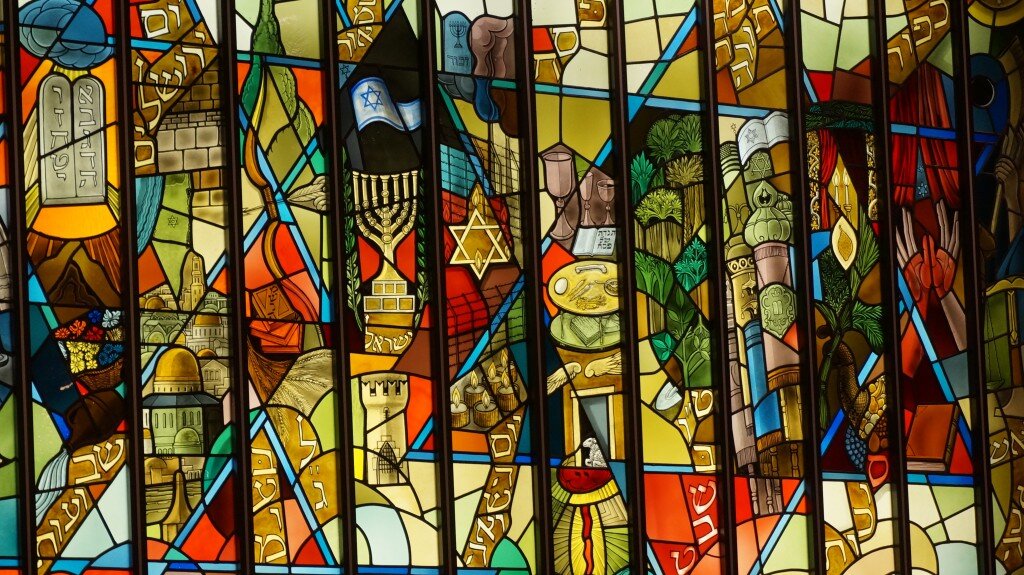
History
About Us
Sutton Place Synagogue was founded more than 100 years ago, in 1901, as Congregation Beth Hamidrash Hachhagadol Talmud Torah, but our roots extend back even before the dawn of the 20th century. That’s when a small Jewish population in the eastern portion of Manhattan’s Midtown area – a neighborhood populated mainly by people of German and Irish ancestry – banded together as a community in order to perpetuate the Jewish life they had left behind in traveling to America.
We’ve never been able to substantiate the rumor that the first quarters of the new synagogue they formed were in a loft above a pool hall, but suffice it to say that Sutton Place Synagogue has evolved from truly humble origins!
A handful of locations and expansions later, all in the Sutton Place area, the new Sutton Place Synagogue was officially opened on September 3, 1975 at 225 East 51st Street. We originally drew from United Nations families but now attract active members from throughout the city and its suburbs.
A common thread throughout our entire proud history is a sense of spiritual and cultural cohesiveness that has brought generations of New York’s Jewish population, regardless of background, together as a single, forward-looking community. It’s with that sense of pride and foresight that Sutton Place Synagogue continues to write its history, each and every day, with new generations of members building on the legacy of our previous generations.
The Early Years
Rabbi Meyer Freeman and eleven other members signed our Synagogue’s incorporation papers on November 6, 1901. Until 1906, this Orthodox synagogue, known as Congregation “Beth Hamedrash Hachodosh Talmud Torah,” was located at 401 East 50th Street above a blacksmith shop.
In 1906, our congregation acquired a building at 221-223 East 51st Street from Congregation Orach Chaim. The Orach Chaim Synagogue had purchased this ornate building on May 20, 1898 from its former occupant, a Methodist mission chapel. After selling the property to our congregation, the Orach Chaim Synagogue relocated uptown to serve the burgeoning Jewish population of that area.
Expansion of Our Synagogue
In the mid 1950’s the synagogue became a Conservative synagogue, known as the East 51st Street Synagogue. The synagogue building at 221-223 East 51st Street occupied a plot of land measuring 40 x 100 feet. Led by Rabbi David Kahane, in the mid 1960’s Simon Syrbnik z”l purchased a plot of land for the synagogue from Con Edison at 225 East 51st Street. The plot measured 20 X 100 feet, thereby creating a total plot of 60 x 100 feet. In 1967 our congregation acquired the Con Edison property at 227 East 51st Street and adjoining plots on the next block, at 224 and 226 East 52nd Street.
In 1971 the Rockerfeller family asked the synagogue to sell them 221 East 51st Street. They had already acquired 217 and 219 East 51st Street. Abby Rockefeller then financed the creation of the beautiful Greenacre Park adjacent to our synagogue.
A New Synagogue Building
As reported in an article in the New York Times on Sunday, January 24, 1965, the East 51st Street Synagogue announced plans to construct a new synagogue building on its present site. The Inaugural Dinner, kicking off the Capital Campaign, was held at the Waldorf-Astoria Hotel on Sunday, May 2, 1965.
The Honorary Chairmen were United Nations Ambassador Arthur Goldberg and US Senators Jacob K. Javits and Abraham A. Ribicoff. The United Nations Secretary-General, U-Thant, sent a message of congratulations to the congregation and welcomed us as the third religious center serving the United Nations, complementing the service rendered by the Protestant Center for the United Nations and the Catholic Holy Name United Nations Parish. Edward I. Koch, who was then congressman, presented the synagogue with a flag that had flown over the Capitol.
During the demolition and construction phase, weekly Shabbat services were held in the former Con Edison building on East 52nd Street and High Holy Day Services were held at the Waldorf-Astoria Hotel. In 1975, Warren Alpert was elected president of the synagogue, and together with Rabbi Kahane, (z’l) and dedicated members of the congregation, oversaw the completion and occupancy of the new facility. On September 3, 1975, our new synagogue building opened. Our congregation then became know as “Sutton Place Synagogue – The Jewish Center for the United Nations.” The Synagogue sold the East 52nd property to real estate developers on October 22, 1980. A residential apartment building now occupies the site.
A building boom occurred in the synagogue community in the late 1970’s and in the ’80s. High-rise apartment buildings sprung up all around us. Many Jewish singles, young couples and “empty-nesters,” occupied the apartments.
Anticipating an increase in membership and the need for future expansion, then synagogue President Jack Sheingold and Rabbi Kahane (z’l) convinced the Board of Trustees to approve the purchase of the adjacent building. On December 11, 1985, the synagogue became the owner of 229 East 51st Street, now the site of the Sachs Family Educational Center.
In the latter half of 1994, Synagogue President Phillip Sassower and Rabbi Richard Thaler (z’l), spearheaded a “Beautification Project” to redesign and decorate the sanctuary. The membership supported the project, both with their time and means. The results were impressive. During the 1995 High Holy Days Services, our members worshipped, surrounded by magnificent furnishings, while seated in comfortable permanent pews, all made in the State of Israel.
Plans for use of the 229 East 51st Street property lay dormant until 1999. Many obstacles made construction undesirable, until architect Avi Malhotra designed a plan that provided for appropriate nursery and religious school classrooms. President Robert W. Berend, with Rabbi Thaler’s (z’l) dream for an educational center in mind, went forward. Chair of the Executive Committee Philip Sassower offered to act as Capital Campaign Chair. With major gifts from various members the campaign was launched. The 229 East 51st Street property was demolished in May 2000.
In September 2000, with just a hole in the ground visible, applications for enrollment in the Kaplan Nursery School came pouring in. And what seemed like an impossibility, was, in fact, a thrilling reality. The Sachs Family Educational Center opened in September 2001 and welcomed its first two-and three-year old Nursery School students and their families. The students of the Jackson Religious School began a new school year in modern state-of-the-art classrooms, a far cry from the temporary classrooms that were erected in the four corners of the synagogue’s ballroom for many years. On December 12, 2001, the Marvin and David Sachs Family Educational Center, the Stanley H. Kaplan Nursery School, and the Nathaniel and Fanny Stricks Jackson Religious School were officially dedicated with a moving ceremony and joyous celebration.
In 2005, under the leadership of Rabbi Allan Schranz, the synagogue became egalitarian, encouraging both men and women, boys, and girls, to take active roles in their Jewish life. There were adult b’nai mitzvah and a growth in adult learning program. Rabbi Schranz’ stirring sermons were a highlight for many in attendance at Shabbat and Holiday services.
In 2012, following the retirement of Rabbi Schranz, Rabbi Rachel Ain was hired to be the synagogue’s Rabbi. Under her leadership, and in partnership with strong lay partners, the synagogue underwent a strategic planning process that not only resulted in a more streamlined volunteer leadership system but a defined mission and vision. During her tenure the synagogue has continued to attract young families to KNS and JRS but has also taken an active role in reaching out to young professionals and empty nesters. Reaching people at every age and stage who want to connect with their own sense of Judaism and Jewish learning in a framework of the Jewish community has been a goal of Rabbi Ain. During this time there was also a desire to match the space with the vision of the synagogue, where the worship experience could feel more intimate. Then president, Dr. Shari Pochapin, in partnership with campaign chairs Dr. Mark Pochapin, Dr. Herb Lepor, and Greg Angrist, led a successful capital campaign where in the summer of 2019 the synagogue’s sanctuary was renovated to create a space that had elements of the past and the present with an eye towards the future.The bimah was lowered for weekly, “in the round” worship and yet the high bimah remained for the more formal experiences on the High Holidays. The pews became movable chairs to allow for ultimate flexibility in worship and programming and livestreaming systems were built into the synagogue. Lastly, the words “How Beautiful it Is When We Sit Together” were placed, in Hebrew and English, on the sanctuary walls flanking the ark, as a reminder that it is our community that makes our worship so special. While the synagogue has adapted during COVID-19 to be virtual, the essence of our services remain the same. They are engaging, inclusive, traditional, and fun.
In the summer of 2020, amidst a global pandemic, Cantor Dov Keren retired after 36 years as the Cantor. He transitioned to becoming Cantor Emeritus, retiring to Florida but remaining active in the community. Dov was beloved by b’nai mitzvah students and shabbat regulars alike. His booming voice and his gentle presence was inspiring. Cantor Malachi Kanfer began his tenure and immediately began to have an impact. He re-started a volunteer choir, became active in the schools, and brought a sense of spirituality and creativity; marrying music, Jewish tradition, and learning all in one.
Sutton Place Synagogue has flourished during these one hundred plus years. We are known throughout New York City and its environs for our inspiring religious services, dynamic speakers, and innovative programs. Now, we turn our eyes to the future.

Clergy that served our community
Rabbi David B. Kahane (z’l), 1949 -1993
Rabbi Richard Thaler (z’l), 1993-1997
Rabbi Allen Schranz (z’l), 1998-2012
Cantor Dov Keren, 1984-Present (Cantor Emeritus since 2020)
Rabbi Rachel Ain, 2012-Present
Cantor Malachi Kanfer, 2020-2023

